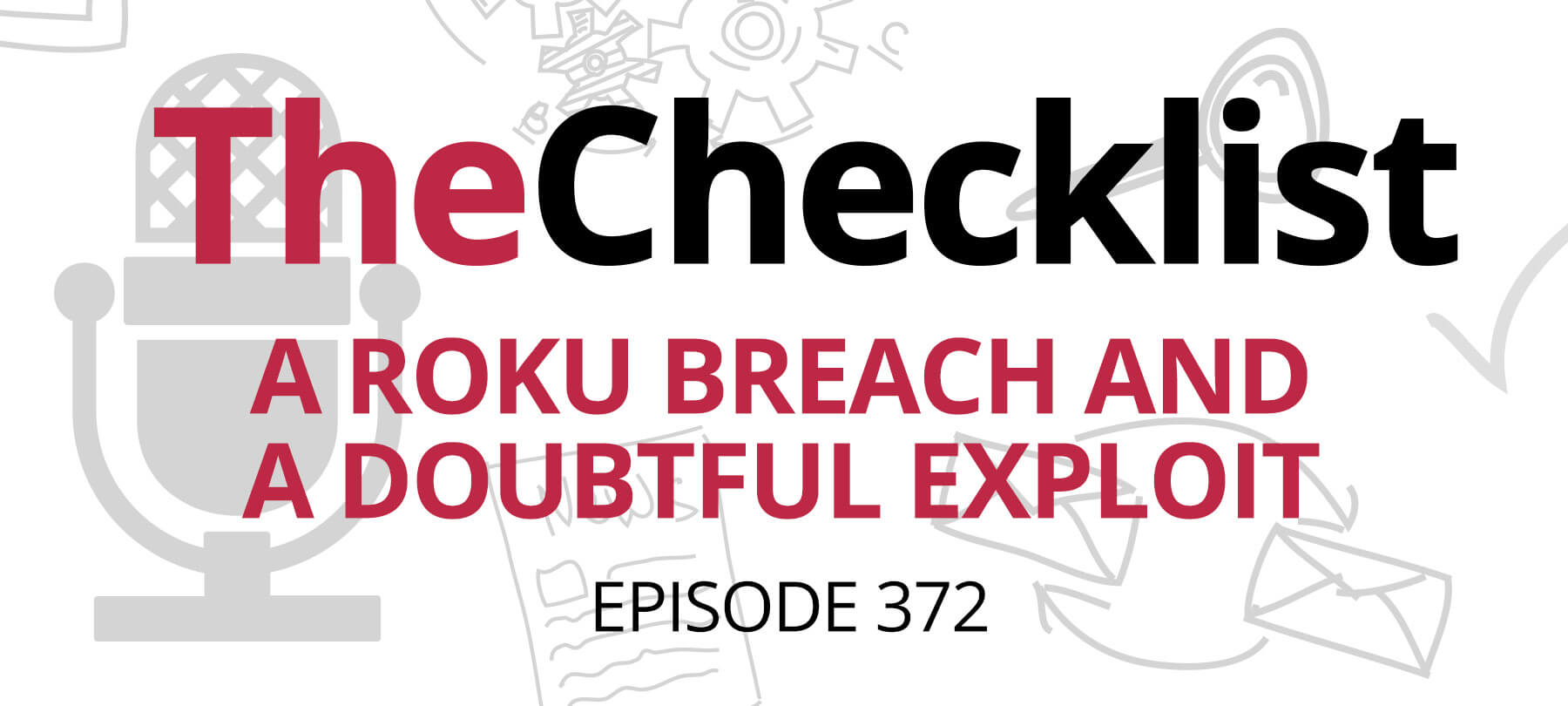
Checklist 372: A Roku Breach and a Doubtful Exploit
Roku Faces Second Data Breach: Over Half a Million Accounts Affected
In a recent podcast discussion, the streaming service and device manufacturer Roku found itself under scrutiny as news broke of a significant security breach. The breach, affecting over half a million accounts, underscores growing concerns regarding data privacy and cybersecurity in the digital age.
The saga began over a month ago, with a disclosure by Roku that approximately 15,000 users had fallen victim to a data breach, wherein account login credentials were compromised through third-party channels. However, the situation escalated drastically when news emerged of a second breach impacting a staggering 576,000 accounts, as reported by Engadget.
Roku, in an official statement, detailed that the unauthorized access stemmed from an increase in unusual account activity detected earlier this year. The breach saw malicious actors gaining entry into accounts through stolen login credentials, albeit without access to sensitive information such as full credit card details.
Despite the potential severity of the breach, Roku assured users that only a fraction of the compromised accounts, less than 400, experienced unauthorized purchases. The company promptly took action by resetting passwords for all affected accounts, notifying users directly, and issuing refunds or reversals for fraudulent transactions.
Moreover, Roku implemented additional security measures to safeguard user accounts, albeit slightly inconveniencing users during the login process. While the company’s response aimed to mitigate the fallout, the incident serves as a stark reminder of the persistent threats posed by cybercriminals and the imperative for robust cybersecurity protocols.
Source: Engadget
Roku Implements Mandatory 2FA Following Data Breach: Lessons Learned from 23andMe Debacle
In a bid to enhance user security, streaming giant Roku has made two-factor authentication (2FA) mandatory for all its users following a recent data breach. The move follows a similar strategy adopted by 23andMe after a previous data privacy incident. According to a report by The Register, Roku attributes the breach to credential stuffing, where attackers utilize login credentials obtained from one service to access another.
In a statement to customers, Roku clarified that there is no evidence suggesting its systems were compromised, indicating that the login credentials used in the attacks were likely sourced from other online accounts where users reused the same credentials. Credential stuffing exploits the common practice of reusing usernames and passwords across multiple platforms, making users vulnerable to cyberattacks.
The implementation of 2FA is seen as a crucial step in mitigating such risks. 2FA adds an extra layer of security by requiring users to provide a second form of authentication, such as a code generated by an authenticator app or biometric verification, in addition to the traditional username and password. Had 2FA been enabled by all users, the likelihood of compromised accounts would have been significantly reduced.
Despite the breach affecting over half a million accounts, there is optimism about the broader adoption of 2FA, given Roku’s extensive user base of over 80 million active accounts. However, users are urged to remain vigilant against phishing attempts, as cybercriminals may exploit the breach to launch fraudulent emails or requests prompting users to click on suspicious links or disclose sensitive information.
In light of these developments, cybersecurity experts emphasize the importance of employing strong, unique passwords and leveraging password managers to safeguard online accounts effectively. With the implementation of 2FA and heightened awareness of cybersecurity threats, Roku aims to bolster user trust and ensure the continued protection of user data.
Source: The Register
Trust Wallet’s iMessage Exploit Warning Raises Concerns: Dubious Sources and Fear-Mongering
Recent alarm bells rang in the tech sphere following a warning from the official Twitter account of Trust Wallet regarding a purported zero-day exploit targeting iMessage. The warning, which garnered over four million views, cautioned users about a high-risk exploit capable of infiltrating iPhones without any user interaction. However, the validity of the warning came under scrutiny due to its dubious source and lack of substantial evidence.
The warning from Trust Wallet referenced “credible intel” obtained from the dark web, suggesting a zero-click exploit targeting iMessage. However, investigations by TechCrunch revealed that the alleged intel was merely an advertisement on a dark web site called CodeBreach Lab, offering the exploit for a hefty sum of $2 million in Bitcoin. Further analysis exposed numerous red flags, including the website’s newness, typos, and a lack of contact information.
Despite the lack of concrete evidence, Trust Wallet’s warning prompted concerns among users, leading to recommendations to disable iMessage until Apple addressed the alleged exploit. However, critics lambasted Trust Wallet for spreading fear, uncertainty, and doubt (FUD) based on unsubstantiated claims. TechCrunch cautioned against the irresponsible dissemination of such warnings and advised users to seek guidance from trusted sources.
In response to the situation, TechCrunch directed users to Lockdown Mode, a feature aimed at enhancing device security by limiting certain functionalities. The incident highlights the importance of verifying information from multiple trusted sources before taking action, particularly in the realm of cybersecurity.
While the warning from Trust Wallet may have been well-intentioned, it underscores the risks associated with relying on unverified sources for critical information. As the tech community navigates the complexities of cybersecurity threats, maintaining vigilance and seeking guidance from credible sources remain paramount.
Source: TechCrunch
